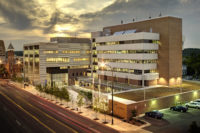DBR Engineering Consultants provides sustainable solutions that maximize efficiencies and return on investment for its clients. DBR, founded in 1972 as David W. Day Associates and later became Day Brown Rice Consulting Engineers (incorporated as DBR Engineering Consultants in 2001), is focused on creating energy-efficient, high-performance MEP building systems.
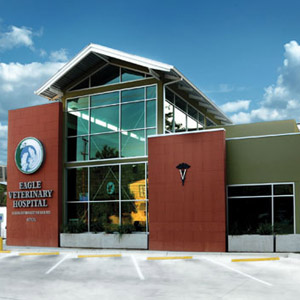
Back in the early days of U.S. Green Building Council’s LEED rating system, several of Texas-based DBR Engineering Consultants’ clients began talking to the firm about the then fledgling concept.
“That’s when we really started learning about LEED,” DBR Partner Brian Uhlrich, P.E., LEED AP BD+C, says. “In 2004, myself and one of the partners attended a LEED workshop and took the exam and became LEED accredited.” Just as Uhlrich and the firm dove deeper into sustainable education, clients began doing the same.
“The more and more we learned about sustainability, the more opportunities came up where architects and building owners were excited about pursuing some sustainable design strategies,” he says. “Up to that point the vast majority of work we did, decisions were made based more on initial budget and keeping first project costs in line than they were on life-cycle cost. More times than not, the intent was to build as cheap as possible and sell it as quickly as possible.”
That mindset, Uhlrich notes, began to slowly change over the years. “The building industry has evolved to where owners care about operating cost,” he says. “They are making an investment in the design of the building and that can yield a good return on that investment. We saw the trend coming and started to explore it and found out a lot of young engineers are excited about sustainable design and are passionate about it.”
Uhlrich, who has been with the firm for 17 years, admits the shift to a green design focus has been a shot in the arm for the 84-person DBR staff, which includes 18 licensed engineers and 10 LEED Accredited Professionals. The firm, celebrating its 40th year in business in 2012, is privately owned by seven partners. Randy Curry is DBR’s president.
“It’s reinvigorated us,” Uhlrich says. “We would rather be a firm with a lot of eager minds invested in exploring new opportunities and technologies instead of a bunch of old codgers doing the same old thing the same way we’ve always done it. It’s been an evolution for us, but it’s been positive and very well-received by our employees.”
It’s also helped move new business through the doors of the firm’s San Antonio, Houston, McAllen and Corpus Christi, Texas, offices.
“There have been projects that have come our way because we’ve earned a reputation in our area and in our region with sustainable designs,” Uhlrich says. “People know we have the experience with LEED projects and know how to obtain all the documentation required. We have a reputation for having a focus on energy efficiency and sustainable design strategies. Our goal is to be recognized in our area as a leader in sustainable designs for building systems.”
Zac Morton, P.E., LEED AP BD +C, has been with DBR for 10 years and is one of those young engineers Uhlrich refers to as having a keen interest in green building design.
“I like the chance to do things that make sense for owners and give them benefits,” he says. “I’m not too big on being green for the sake of being green. I want it to be good in the long run for the owner and for the environment.”

Scope of work
DBR, founded in 1972 as David W. Day Associates and later became Day Brown Rice Consulting Engineers (incorporated as DBR Engineering Consultants in 2001), is focused on creating energy-efficient, high-performance MEP building systems. The firm also provides energy modeling, energy audits, commissioning and LEED consulting services and recently entered into the security and surveillance systems arena.
DBR’s market focus spans a host of commercial and industrial segments, including education, retail, municipal, hospitality, health care, commercial housing and government. The firm’s Houston affiliate is heavily involved in the construction of sustainable high-rise buildings. “Most new speculative office buildings in Houston are being constructed and targeting LEED Silver at a minimum to compete in the marketplace,” says Uhlrich, who adds the San Antonio office does a lot of education and government work.
With the hotter climate in southern Texas, DBR focuses a good chunk of its attention on HVAC systems. “We see that as the single biggest energy user in our region,” Uhlrich says. “Most buildings in the southern part of Texas are cooling nearly year-round. The HVAC system - and the cooling system in particular - is usually the No. 1 energy user in the building. We zero in on energy-efficient systems. There are a lot of different techniques we can use to pursue that.” Water conservation also weighs heavily into the firm’s designs.
Water conservation is a major issue here,” Uhlrich says. “We’ve been suffering a pretty severe drought the last three years and the last year in particular. Water has always been a sensitive and precious resource in this area. Local government has some restrictions that other areas don’t have as far as conserving water. We focus on efficient plumbing fixtures, reclaiming condensate waste and harvesting rainwater. We’re always looking for different ways to use the water.”
DBR also is progressive in how it creates designs, using building information modeling to its benefit, particularly Autodesk’s Revit.
“We use Revit to produce probably two-thirds to three-fourths of our work,” Uhlrich says. “All our design staff is trained on it and actively working on projects with it. We now have a full-time BIM manager (Paul Kimbrell) who is really helping us. It’s been a transformation. We had 20 years of standards in a library and 20 years of details with AutoCAD. Now we have four or five years’ worth of experience with Revit. It’s an ongoing process to develop a standard library and develop custom details and customizing the software for our needs. We’re getting to the point where we are able to deliver information in a model that building owners can use to manage facilities long-term.”
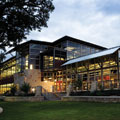
Barking up the green tree
DBR is the engineer of record on a project at the Eagle Veterinary Hospital in Olmos Park, Texas. The Eagle hospital, owned by Dr. Kenneth Kirlin, is the first LEED Platinum-certified building in the San Antonio area.
“We’re very proud of that,” Uhlrich says of the Platinum designation. “Dr. Kirlin is a vet and a businessman. He had a small facility and had a dream to build a bigger facility and expand the business. He had this vision of building a green and environmentally responsible building. He felt strongly about his personal convictions. He felt it was the right thing to do and that it would give him a competitive advantage because his customers would respect the fact he is being sensitive to the natural environment.”
Mdn Architects (the architect of record), DBR and Kirlin went to work on designing the facility, which now spans two stories and 10,500 sq. ft.
“The architect is extremely passionate about green building,” Uhlrich says. “Between the architect, ourselves and the owner leading the way, we put a tremendous amount of effort into making the building as sustainable as possible.”
The centerpiece of the green design is a rainwater collection system that has drastically lowered the hospital’s water bills. Three 3,400-gal. CorGal tanks collect rain from the roof and condensate from mechanical equipment. That water is filtered and treated and fed to a pumping station, which supplies all non-drinking water to the building.
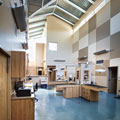
“State regulations say you are not allowed to use reclaimed water for drinking water purposes in a building unless you are off-grid and don’t have access to a water supply,” Uhlrich says. “We had to tap off the city water supply for two outlets in the building that are used for drinking water. Every other sink, including ones used for pet bathing and doctor hand-washing in the exam rooms, uses reclaimed water.”
The savings the rainwater system generates are substantial. “I’ve heard Dr. Kirlin say his water bill has never been more than $20 a month in the new building and water is expensive in the San Antonio area,” Uhlrich says. “Even with the severe drought, the condensate from the air conditioning alone is enough for him to do his landscaping and for all inside uses except drinking water.”
Water savings also are achieved through the use of low-flow fixtures, including Caroma dual-flush water closets (1.28 gpm or 0.8 gpm), American Standard lavs and Elkay stainless-steel sinks.“They use no city water to flush the fixtures. It’s all reclaimed water,” Uhlrich adds.
He labels the air-conditioning technology in the pet hospital as “not particularly cutting-edge technology.” Still, sustainability and energy consumption are major parts of the equation.
“The building has package rooftop units, but we used high-efficiency ones,” he says. “Dr. Kirlin has an operating room that looks like a human operating room and there are isolation rooms where sick animals are kept. We controlled the air pressure of these spaces relative to one another. There is a lot of ventilation, a lot of air being exhausted from the building and a lot of fresh air being brought in. The challenge is to do that while being sensitive to energy use.”
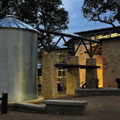
Trane rooftop units feature hot gas reheat for humidity control and CO2 sensors modulate the control of outside air, which also is limited by building differential pressure sensors.
“We are always maintaining pressure relationships within the building,” Uhlrich says. “We provided air-flow measuring stations at each of the units. We used VAV terminals to measure the outside airflow of each unit in order to comply with the LEED credit for outdoor air delivery monitoring.”
The hospital’s electric bills also have taken a tumble despite the size disparity between the old and new buildings. “Dr. Kirlin has noted this building is more than twice the size of his old facility and yet his electric bills do not reflect this. Without the green features, he couldn’t afford the bills with the size of the building he has now.”
With the facility using photovoltaic power and the energy efficiency strategies, Uhlrich notes the firm’s energy model demonstrated 49% energy savings for the building over the baseline model.
Uhlrich and his team also put its energy modeling skills to work on the pet hospital project and helped Kirlin earn a key utility rebate.
“We took the energy model (in accordance with the LEED green building rating system) and prepared a report for the utility company,” he says. “It was the first project the local utility company awarded a custom commercial rebate for.”
Uhlrich explains in previous times if a building went out of its way to invest in energy efficiency there was no formula in place to award a rebate, whereas if an owner replaced an A-C unit with a more efficient version, a rebate would be issued.
“We took our results and compared the projected energy performance of our building against a baseline and they used that data to calculate a rebate,” he says. “We are proud to be the first ones who helped set the standard for that. More importantly, the building owner got to see some return on investment, which validated his decision to go green.”
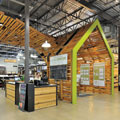
Seeing green
DBR currently has 36 completed LEED-certified projects to its credit and another 24 registered and in the design process. Some recent notable projects include retail space in Austin, Texas, for TreeHouse, a home-improvement product retailer, and work for Alamo Heights Independent School District where an ice-storage system was used in one of the schools to reduce peak electrical demands while creating increased capacity to handle new additions without adding new A/C equipment. Five hundred kW of solar power systems were specified for schools in the district.
The Patrick Heath Public Library, a LEED Gold facility in Boerne, Texas, features rainwater harvesting and has drawn considerable praise. The firm also recently completed sustainable design work on a residential dorm project at Baylor University.
“We don’t see any slowing down with green building,” Uhlrich says.
Morton, who like Uhlrich is a Kansas State graduate (DBR does a healthy amount of recruiting from KSU due to the university’s strong engineering program), points out in this current economic climate where dollars are being stretched to the limit, it’s not too hard to convince a building owner to make a sustainable leap of faith.
“School districts want to build buildings that last 40 or 50 years,” he says. “They can afford to put in a little more in order to see that payback. A lot of owners are coming around and seeing the benefits of building green.”
But Uhlrich says getting buildings certified by sustainability programs is becoming tougher. He notes the stakes in the green building design game are constantly being raised.
“We see code requirements continuing to become more stringent,” he says. “Now, you need to go beyond the baseline and the code minimum. We see the design and construction industry moving more and more into truly green designs. We’ll look back in a couple years on the work we did and laugh that it really wasn’t sustainable compared to what we’re doing now. I strongly believe in a few years the things we do today won’t be considered green. We’ll have to go a lot further if we want to be green. The good news is much of the design community is eager to progress.”
And DBR is at the head of the class in that progression. “Our firm has a real impact on reducing energy consumption and reducing the drain on natural resources,” Uhlrich says.

